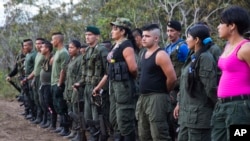The Nobel Peace Prize awarded to Colombia's President Juan Manuel Santos is likely to give a boost to the country's efforts to end a half-century of hostilities with leftist rebels. The Associated Press explains how the conflict began and developed over the decades.
How it started
The 1948 assassination of populist firebrand Jorge Eliecer Gaitan led to a political bloodletting known as " The Violence.'' Tens of thousands died, and peasant groups joined with communists to arm themselves.
A 1964 military attack on their main encampment led to the creation of the Revolutionary Armed Forces of Colombia, or FARC.
What the rebels wanted
Though nominally Marxist, the FARC's ideology has never been well defined. It has sought to make the conservative oligarchy share power and prioritized land reform in a country where more than 5 million people have been forcibly displaced, mostly by far-right militias in the service of ranchers, businessmen and drug traffickers.
The FARC lost popularity as it turned to kidnapping, extortion and taxes on cocaine production and illegal gold mining to fund its insurgency.
How the US got involved
In 2000, the United States began sending billions of dollars to counter drug-trafficking and the insurgency under " Plan Colombia,'' which helped security forces weaken the FARC and kill several top commanders.
The State Department classifies the FARC as a terrorist organization and its leaders face U.S. indictments on drug-trafficking charges.
The human toll
More than 220,000 lives have been lost, most of them civilians, and almost 8 million people have been driven from their homes in the conflict. In the past two decades, most of the killings were inflicted by the militias, which made peace with the government in 2003.
The FARC abducted ranchers, politicians and soldiers and often held them for years in jungle prison camps. Its captives included former presidential candidate Ingrid Betancourt and three U.S. military contractors, all of whom were rescued in 2008.
Peace efforts
Mid-1980s peace talks collapsed after death squads killed at least 3,000 allies of the FARC's political wing. Another peace effort fell apart in 2002 after the rebels hijacked an airliner to kidnap a senator.
The latest peace talks began formally in 2012 and concluded last month when a deal was signed by Santos and FARC leader Timochenko. A few days later, however, it was narrowly rejected by Colombian voters in an Oct. 2 referendum, forcing both sides back to the drawing board.
The accord included provisions on land reform, combating drug trafficking, guerrillas' political participation and punishment for war crimes on both sides. It also clears the way for an estimated 7,000 FARC fighters will lay down their weapons to U.N. observers.




